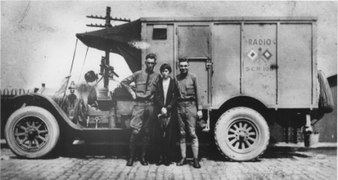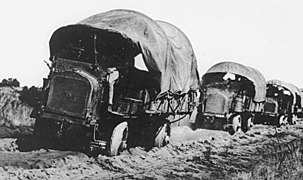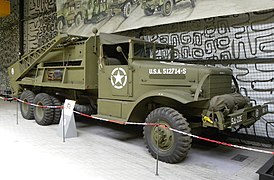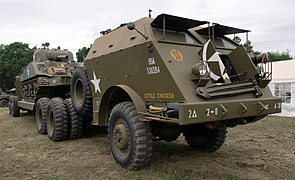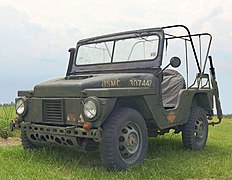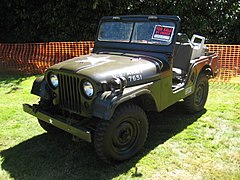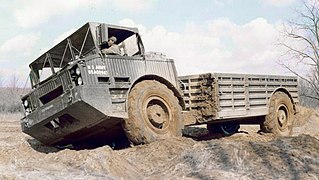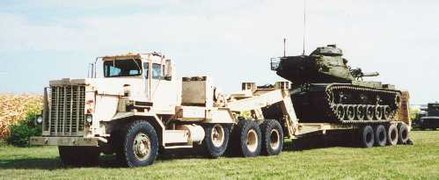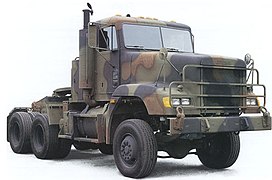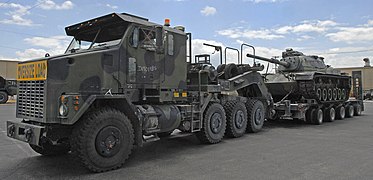
The Heavy Expanded Mobility Tactical Truck (HEMTT) is an eight-wheel drive, diesel-powered, 10-short-ton (9,100 kg) tactical truck. The M977 HEMTT first entered service in 1982 with the United States Army as a replacement for the M520 Goer, and since that date has remained in production for the U.S. Army and other nations. By Q2 2021, around 35,800 HEMTTs in various configurations had been produced by Oshkosh Defense through new-build contracts and around 14,000 of these had been re-manufactured. Current variants have the A4 suffix.

Mack Trucks, Inc. is an American truck manufacturing company and a former manufacturer of buses and trolley buses. Founded in 1900 as the Mack Brothers Company, it manufactured its first truck in 1905 and adopted its present name in 1922. Since 2000, Mack Trucks has been a subsidiary of Volvo, which purchased Mack and its former parent company Renault Véhicules Industriels.

The Dodge M37 was a 3⁄4-ton 4x4 truck developed for service in the United States military as a successor to the widely used Dodge-built WC Series introduced during World War II. Put into service in 1951, it served in a variety of configurations in frontline duty in the Korean War and War in Vietnam before being replaced by two commercial off the shelf (COTS) based 1+1⁄4-ton trucks: the Kaiser M715 and the Dodge M880/M890 series.

The Family of Medium Tactical Vehicles (FMTV) are a series of military vehicles based upon a common chassis, varying by payload and mission requirements. The FMTV is derived from the Austrian Steyr 12M18 truck, but substantially modified to meet United States Army requirements. These include a minimum 50 percent U.S. content.

The M939 is a 5-ton 6×6 U.S. military heavy truck. The basic cargo versions were designed to transport a 10,000 pounds (4,500 kg) cargo load over all terrain in all weather. Designed in the late 1970s to replace the M39 and M809 series of trucks, it has been in service ever since. The M939 evolved into its own family of cargo trucks, dump trucks, semi-tractors, vans, wreckers, and bare chassis/cabs for specialty bodies. 44,590 in all were produced.

The M35 2½-ton cargo truck is a long-lived 2½-ton 6×6 cargo truck initially used by the United States Army and subsequently utilized by many nations around the world. Over time it evolved into a family of specialized vehicles. It inherited the nickname "Deuce and a Half" from an older 2½-ton truck, the World War II GMC CCKW.
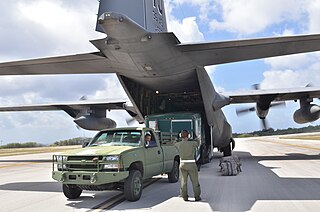
The Commercial Utility Cargo Vehicle, later the Light Service Support Vehicle (LSSV), is a vehicle program instituted to provide the United States military with light utility vehicles based on a civilian truck chassis.

The 1+1⁄4-ton, 4×4, Kaiser Jeep M715, sometimes called the "Five quarter (ton)", for its 1+1⁄4 ton payload rating, is an American light military truck, based on the civilian Jeep Gladiator (SJ). Design and development for the M715 began in 1965, intended to replace the Dodge M37. In a departure from its purpose-built predecessor, the M715 was the first "M"-series U.S. tactical vehicle to use primarily commercial components; the first in a series of militarized commercial off-the-shelf (COTS) vehicle procurements.

The M39 series 5-ton 6×6 truck (G744) was a family of heavy tactical trucks built for the United States Armed Forces. The basic cargo version was designed to transport a 5-ton (4,500 kg), 14 ft (4.3 m) long load over all terrain in all weather. In on-road service the load weight was doubled.

The GMC CCKW, also known as "Jimmy", or the G-508 by its Ordnance Supply Catalog number, was a highly successful series of off-road capable, 21⁄2-ton, 6×6 trucks, built in large numbers to a standardized design for the U.S. Army, that saw heavy service, predominantly as cargo trucks, in both World War II and the Korean War. The original "Deuce and a Half", it formed the backbone of the famed Red Ball Express that kept Allied armies supplied as they pushed eastward after the Normandy invasion.

The G-506 trucks, 1+1⁄2-ton, 4x4, produced as the Chevrolet G7100 models, were a series of (light) medium four wheel drive trucks used by the United States Army and its allies during and after World War II. This series came in standard cargo, as well as many specialist type bodies.

The Dodge WC series is a prolific range of light 4WD and medium 6WD military utility trucks, produced by Chrysler under the Dodge and Fargo marques during World War II. Together with the 1⁄4-ton jeeps produced by Willys and Ford, the Dodge 1⁄2‑ton G-505 and 3⁄4‑ton G-502 trucks made up nearly all of the light 4WD trucks supplied to the U.S. military in WWII – with Dodge contributing some 337,500 4WD units.

The Willys MC, formally the 1⁄4-Ton, 4 x 4, Utility Truck M38, or the G‑740 by its U.S. Army Standard Nomenclature supply catalog designation, is a quarter-ton four-wheel drive military light utility vehicle made by Willys between 1949 and 1952. It replaced, and succeeded the World War II Willys MB and Ford GPW models, with a total production of some 50,000 units — less than one tenth the number of WWII models built. Unlike during WWII, Ford was no longer involved in the production.

The M915 is a tractor unit used for line haul missions by the United States Army. Designed for use on improved roads, it does not have a driven front axle.

The Mack M123 (G792) was a 10-ton 6x6 semi-tractor introduced in 1955. The Mack M125 was a heavy cargo truck version of the M123. The M123 was used to tow tank transporter trailers while the M125 towed field artillery pieces.

Mack Trucks has been selling heavy duty trucks and buses to the United States military since 1911. Virtually every model has been used. The majority have been commercial models designed and built by Mack with their own components, but they have also designed and built military specification tactical trucks. The military vehicles are rated by payload measured in tons.
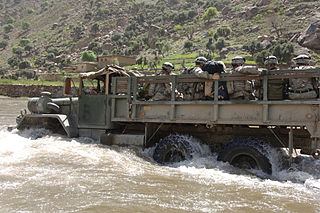
The M809 Series 5-ton 6x6 truck (G908) was a family of heavy tactical trucks built for the United States Armed Forces. The basic cargo version was designed to transport a 5-ton (4,500 kg), 14 ft (4.3 m) long load over all terrain in all weather. In on-road service the load weight was doubled. Built by AM General, they evolved into the M939 Series.

The 5‑ton 6x6 truck, officially "Truck, 5-ton, 6x6", was a class of heavy-duty six-wheel drive trucks used by the US Armed Forces. The basic cargo version was designed to transport a 5-ton (4,500 kg) load over all roads and cross-country terrain in all weather. Through three evolutionary series there have been component improvements, but all trucks were mechanically very similar. They were the standard heavy-duty truck of the US military for 40 years, until replaced by the Medium Tactical Vehicle (MTV) beginning in 1991.

The 2+1⁄2-ton, 6×6 truck was a standard class of medium duty trucks, designed at the beginning of World War II for the US Armed Forces, in service for over half a century, from 1940 into the 1990s. Also frequently known as the deuce and a half, or just deuce, this nickname was popularized post WWII, most likely in the Vietnam War era. The basic cargo versions were designed to transport a cargo load of nominally 2+1⁄2 short tons over all terrain, in all weather. The 2+1⁄2-ton trucks were used ubiquitously in World War II, and continued to be the U.S. standard medium duty truck class after the war, including wide usage in the Korean and Vietnam Wars, as well as the first Gulf War.

